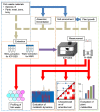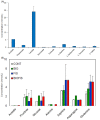Visualization of Microfloral Metabolism for Marine Waste Recycling
- PMID: 26828528
- PMCID: PMC4812336
- DOI: 10.3390/metabo6010007
Visualization of Microfloral Metabolism for Marine Waste Recycling
Abstract
Marine biomass including fishery products are precious protein resources for human foods and are an alternative to livestock animals in order to reduce the virtual water problem. However, a large amount of marine waste can be generated from fishery products and it is not currently recycled. We evaluated the metabolism of digested marine waste using integrated analytical methods, under anaerobic conditions and the fertilization of abandoned agricultural soils. Dynamics of fish waste digestion revealed that samples of meat and bony parts had similar dynamics under anaerobic conditions in spite of large chemical variations in input marine wastes. Abandoned agricultural soils fertilized with fish waste accumulated some amino acids derived from fish waste, and accumulation of l-arginine and l-glutamine were higher in plant seedlings. Therefore, we have proposed an analytical method to visualize metabolic dynamics for recycling of fishery waste processes.
Keywords: NMR; anaerobic fermentation; marine waste; soil amendment.
Figures




Similar articles
-
Upflow anaerobic sludge blanket reactor--a review.Indian J Environ Health. 2001 Apr;43(2):1-82. Indian J Environ Health. 2001. PMID: 12397675 Review.
-
Closing the phosphorus cycle in a food system: insights from a modelling exercise.Animal. 2018 Aug;12(8):1755-1765. doi: 10.1017/S1751731118001039. Epub 2018 May 21. Animal. 2018. PMID: 29779495
-
Nitrogen availability and indirect measurements of greenhouse gas emissions from aerobic and anaerobic biowaste digestates applied to agricultural soils.Waste Manag. 2013 Dec;33(12):2641-52. doi: 10.1016/j.wasman.2013.08.005. Epub 2013 Sep 10. Waste Manag. 2013. PMID: 24035244
-
Concentrations, profiles, and estimated human exposures for polychlorinated dibenzo-p-dioxins and dibenzofurans from electronic waste recycling facilities and a chemical industrial complex in Eastern China.Environ Sci Technol. 2008 Nov 15;42(22):8252-9. doi: 10.1021/es8017573. Environ Sci Technol. 2008. PMID: 19068802
-
Valuable Compound Extraction, Anaerobic Digestion, and Composting: A Leading Biorefinery Approach for Agricultural Wastes.J Agric Food Chem. 2018 Aug 15;66(32):8451-8468. doi: 10.1021/acs.jafc.8b02667. Epub 2018 Aug 2. J Agric Food Chem. 2018. PMID: 30010339 Review.
Cited by
-
Improvement of physical, chemical, and biological properties of aridisol from Botswana by the incorporation of torrefied biomass.Sci Rep. 2016 Jun 17;6:28011. doi: 10.1038/srep28011. Sci Rep. 2016. PMID: 27313139 Free PMC article.
-
Methanethiol generation potential from anaerobic degradation of municipal solid waste in landfills.Environ Sci Pollut Res Int. 2017 Oct;24(30):23992-24001. doi: 10.1007/s11356-017-0035-x. Epub 2017 Sep 6. Environ Sci Pollut Res Int. 2017. PMID: 28879507
-
Trans-omics approaches used to characterise fish nutritional biorhythms in leopard coral grouper (Plectropomus leopardus).Sci Rep. 2017 Aug 24;7(1):9372. doi: 10.1038/s41598-017-09531-4. Sci Rep. 2017. PMID: 28839183 Free PMC article.
-
The exposome paradigm to predict environmental health in terms of systemic homeostasis and resource balance based on NMR data science.RSC Adv. 2021 Sep 13;11(48):30426-30447. doi: 10.1039/d1ra03008f. eCollection 2021 Sep 6. RSC Adv. 2021. PMID: 35480260 Free PMC article. Review.
References
-
- Murata M., Nakazoe J.-I. Production and use of marine algae in japan. Jpn. Agric. Res. Q. 2001;35:281–290.
LinkOut - more resources
Full Text Sources
Other Literature Sources
Molecular Biology Databases

